-
Posts
525 -
Joined
-
Last visited
Posts posted by Amizaur
-
-
Of course - the reason for introducing the wide mantlet was moving the gunner's sight further from the gun.
But changes were done only to the left side of the turret, and to the mantlet a thinner part covering the gunsight area was added. But the central thick part of the mantlet was unchanged, as far as I know at the moment.
So if there was any shot trap, it would be unchanged by narrow -> wide modernisation. Currently I do not believe that any particualry vunerable area was under the mantlet (at least if the barrel was set in horizontal position), so there was no need to change anything there. Front turret armor under the mantlet was thicker than corresponding part of armor over the mantlet and it was done this way by design.
-
Is it modeling of hull or turret that makes such big difference between early and late IS-2 in CM?
-
I've seen this data somwhere on the net, and I trust Jason citied it correctly. That is all I need personally now. I don't write any historical thesis at the moment :). Some of it is probably from here: http://english.battlefield.ru/tanks/10-heavy-tanks/19-js-2.html and if not, better sources are listed at bottom of the page, like "Studying the JS tanks being destroyed in summer-autumn 1944", NII-48, Sverdlovsk, 1945;
-
ASL Veteran - Jason reputation as person with good knowledge about WW2 tanks is just good as cited source :). This data can be found without problem on the net (russian battefield site I guess) if you need it.
I admit that I have also noticed strange lack of evidence for front turret penetrations of IS tanks. There are very few photos of such penetrations (I have counted 2 or 3) and not much combat reports. Either IS front turret was - in practice - stronger that it theoretically should be...
Or just IS tanks, after the initial suprise and some partially-succesfull front-attack attempts, were rarely (if at all) enagged from the front, German tanks maneuvered to engage from the side (untill long 88mm guns appeared).
Front vunerable areas were small (some flat front turret areas and big front lower plate - the upper plate was not that vunerable and was quite small anyway) so in frontal enagements at over 500m many shots or much luck was needed to even hit there. Target possible to kill, but really hard, so decision to avoid frontal engagements was optimal.
And - as the above Jason data shows - IS-2 from side aspect is easy (big and not especially hard to penetrate at any point) target, can be knocked out even by Stugs from +1000m.
So maybe just the vunerable front turret areas were small, not many shots fired in initial engagements actually hit there, and later frontal engagements were in general avoided, side-shots were preffered.
Personally I can consider the front turret armor being 10...20% more resistant than it "should" - because of it's spherical shape or high hardness steel or something like that. But not more. The spherical sides left and right of mantlet are just 100mm thick, I inspected them from outside and inside.
The mantlet is not more than 115- 120mm thick at thickest part (few centimeters above the gun axis). The area directly around the gun is about 200mm but it's very small "ring" of armor wrapped around the gun tube.
Mantlet was mounted to the gun tube sleeve with 4 big screws, on a rubber shock-absorbing pads (I guess that "floating" mouting on amortising pad could increase mantlet resistance by one or few percents).
The front turret should not be more resistant than 90...120mm of RHA (depending on T/D ratio and accounting for hard casting) and mantlet not more than 100..140mm (as above). And even those higher numbers are definitely within reach of KwK36 under 1000m.
Areas close to mantlet edge (both edge of mantlet and edge of turret opening for gun) should suffer from free edge effects and provide protection less than 100mm.
P.S. I just found some info suggesting that mantlets of early IS-1 (IS-2?) was made from bent 100mm RHA slab. But I didn't see any photo of any IS with RHA mantlet. Maybe is was info about some prototype or project. All IS-2 mantlets are definitely cast pieces. It's much easier to produce.
I'm still wondering why the mantlet is 115mm thick, when front turret only 100mm thick. Why 115 ? 100mm of RHA when "corrected" to be made with cast armor of the same resistance would give about 115mm. But it's probably wrong theory. The mantlet design thickness may be not 115mm but 110mm or 120mm as well, and the measured number is just inaccuracy of poor casting process. On all large cast parts there are differences in thickness (measured in various points) up to +/- 10mm.
On the other hand, do not believe that the design thickness of the mantlet could be 100mm and the measured 115mm caused by such large casting/mould inaccuracy. That would be too big error even for Russian war production realies. +/-5mm for mantlet are plausible (just as +/-10mm for large, more expensive parts like front hull). +15mm for small part like mantlet is too much, such mantlet would be scrapped I think.
-
For early Is-2 with narrow mantlet there is almost no overlapping mantlet + turret armor. There is either 100mm (max) of front turret armor OR 100...115mm (max) of mantlet armor.
Here is IS-1 turret armo - the IS-2 with narrow mantlet would have almost identical layout, only the separate frontal would be little longer, because the big 122mm gun had to be mounted little more forward (pivoting point moved ahead of the joint):
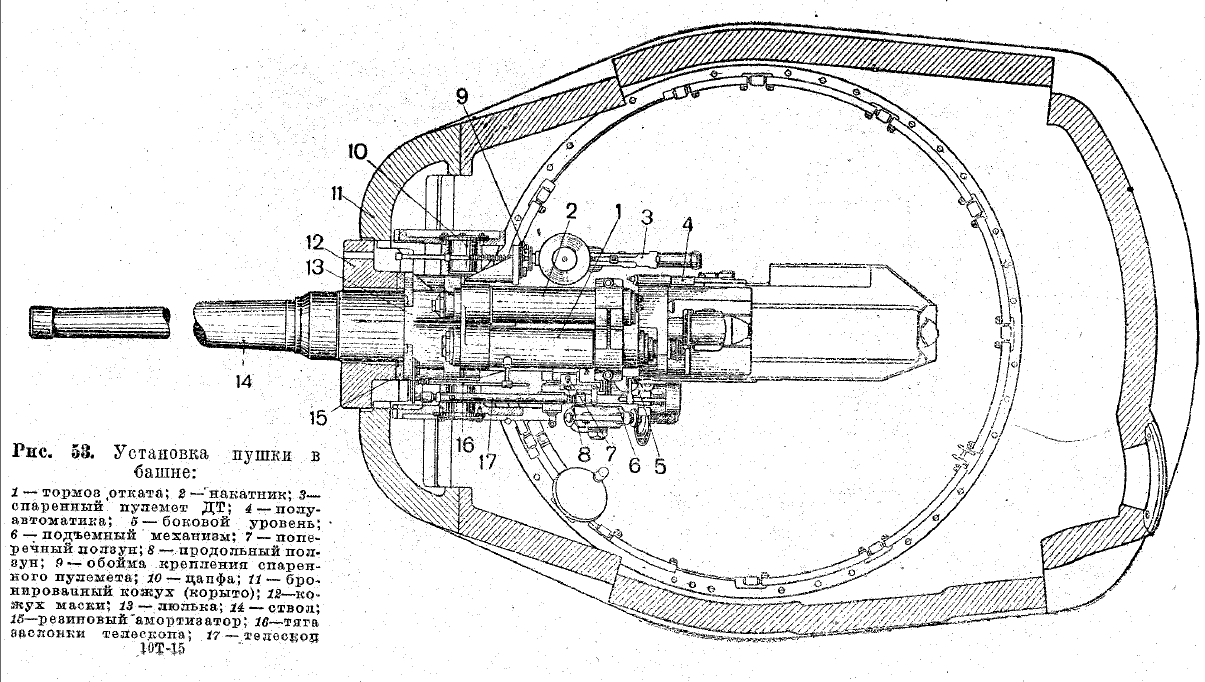
The wide mantlet is max 115mm thick (120mm in some reinforced areas), the narrow mantlet was either the same (115mm) or only 100mm thick. I had no occasion to measure narrow one yet.
P.S. I wonder why Russians after testing Is-2 mod 1943 against KwK36 reported that the front turret cannot be penetrated, when upper hull could be penetrated up to 600m, lower hull up to 1400m, sides of turret (100mm cast) up to 2500m o even more. Sides and rear of turret is 100mm thick all around, the bolted-in front turret casting is same thickenss. Maybe they were made of different hardness or material ? Or maybe the spherical shape made them some percent more resistant than a flat plate (in the same way as architectonic arcs works?) Or it's just a bogus info, because at the same time they called for front turret armor reinforcement to 130mm (which could not be done because of turret unbalance as we know).
In theory the central flat areas of front turrret should not be more resistant than flat areas of side turret (or even slightly less because side turret is always little sloped in vertical).
Are there any reports (German?) about Is-2 front turret penetration distances by various guns ? I mean combat reports or ballistic tests, not calculated ones...?
-
Correction to the transition region picture: I studied the blueprint a bit more and I see it should rather look like that:
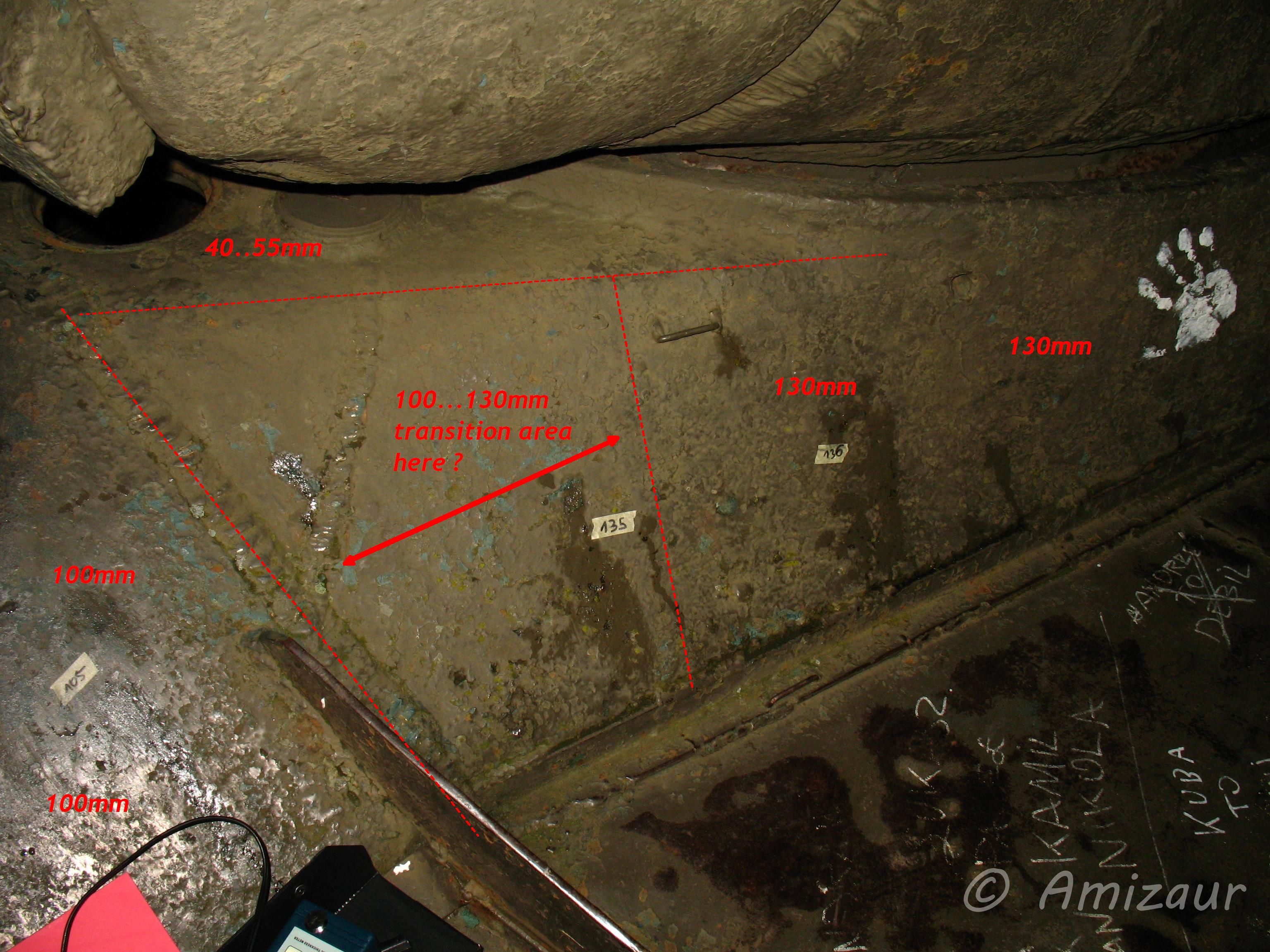 IS-2 transition region correct by Marcin Ostrowski, on Flickr
IS-2 transition region correct by Marcin Ostrowski, on Flickr -
 100m front uppper plate - diagram by Marcin Ostrowski, on Flickr
100m front uppper plate - diagram by Marcin Ostrowski, on Flickr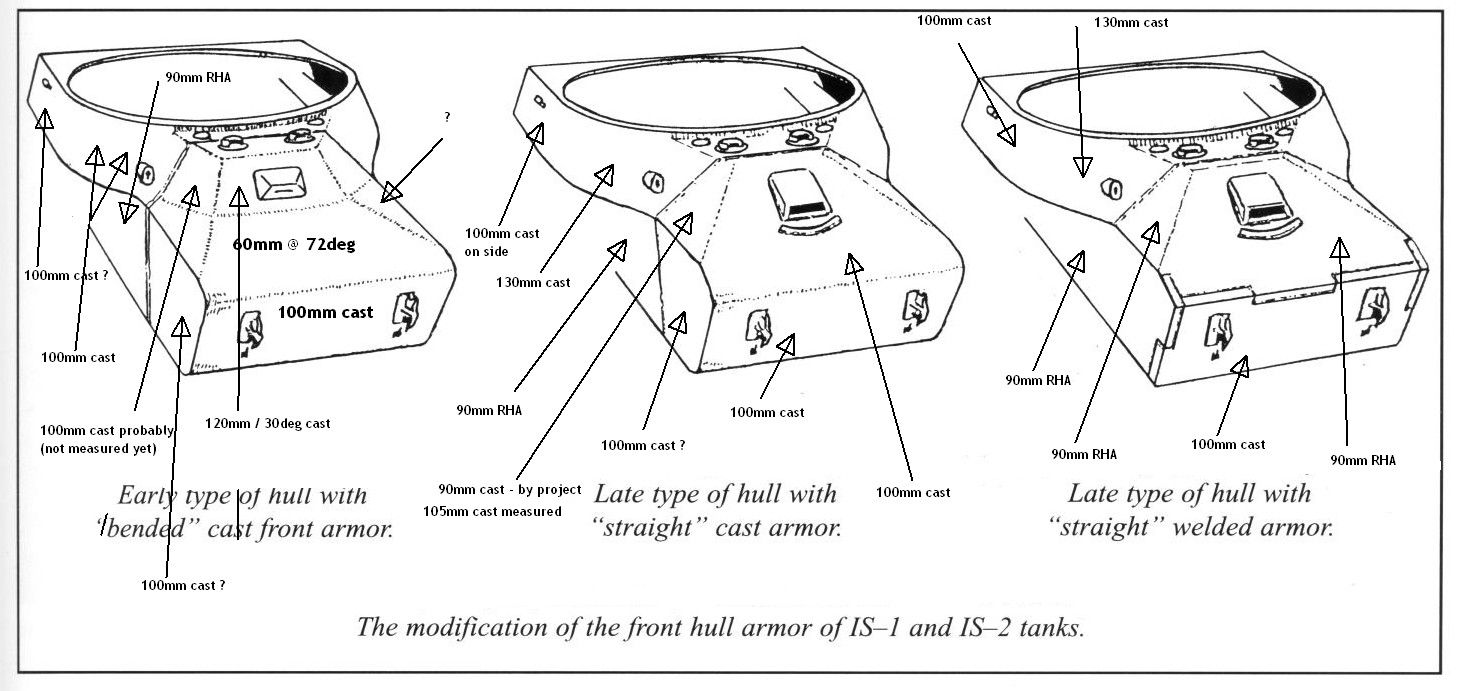 IS-2 front hull versions with thickness by Marcin Ostrowski, on Flickr
IS-2 front hull versions with thickness by Marcin Ostrowski, on Flickr(Two transition areas for upper front-side and side armor belts are not shown on the picture above). First one is on the front where the 100mm nose plate is welded to 100mm front-side belt, then over lenght of 25cm the thickness inreases to 130mm. Second transition from 130mm to 100mm is where the front-side belt turns into side part (under side of the turret). Armor changes from 130mm to 100mm over lenght of 30cm.)
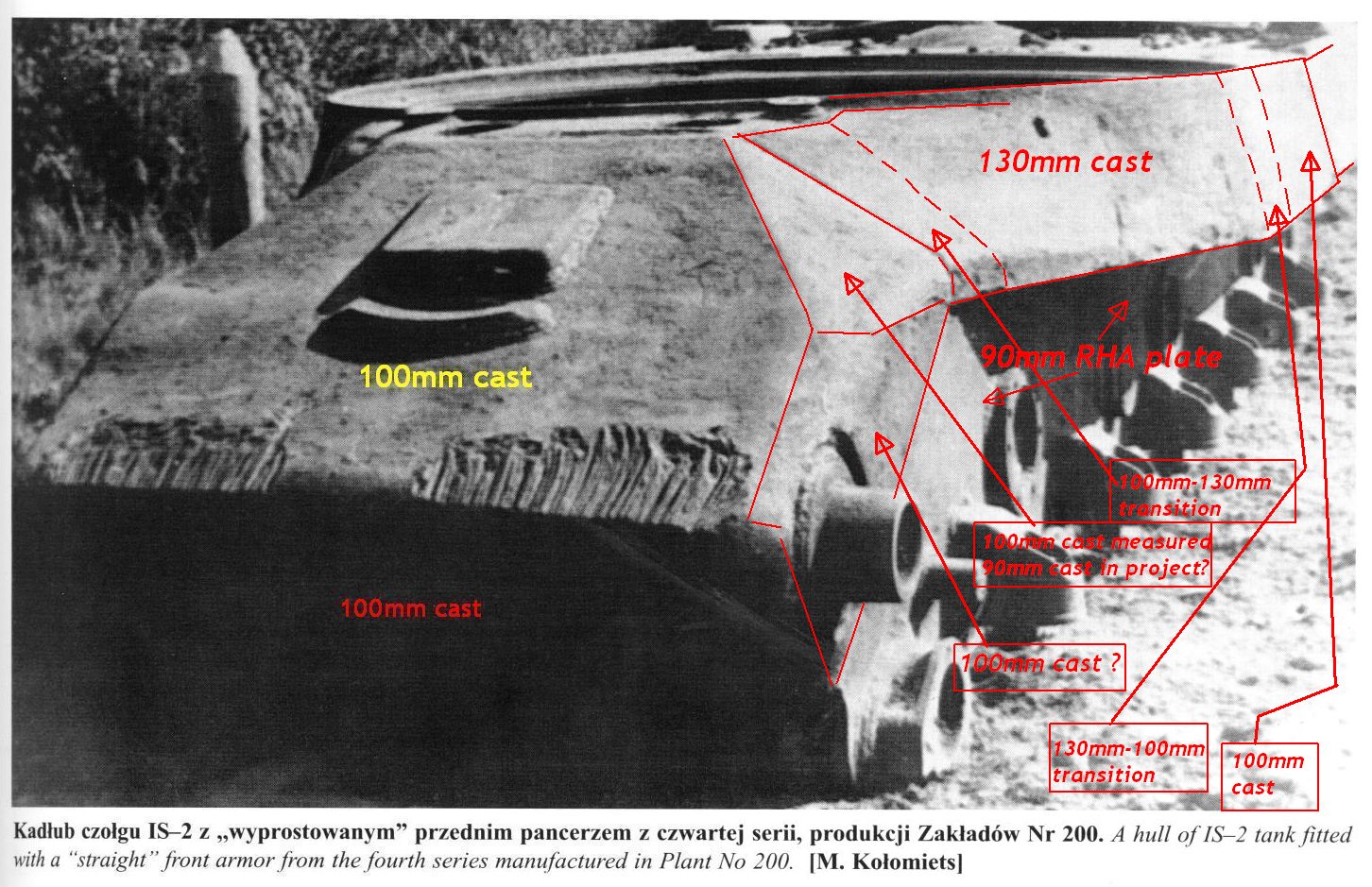 IS-2m cast hull z opisami by Marcin Ostrowski, on Flickr
IS-2m cast hull z opisami by Marcin Ostrowski, on Flickr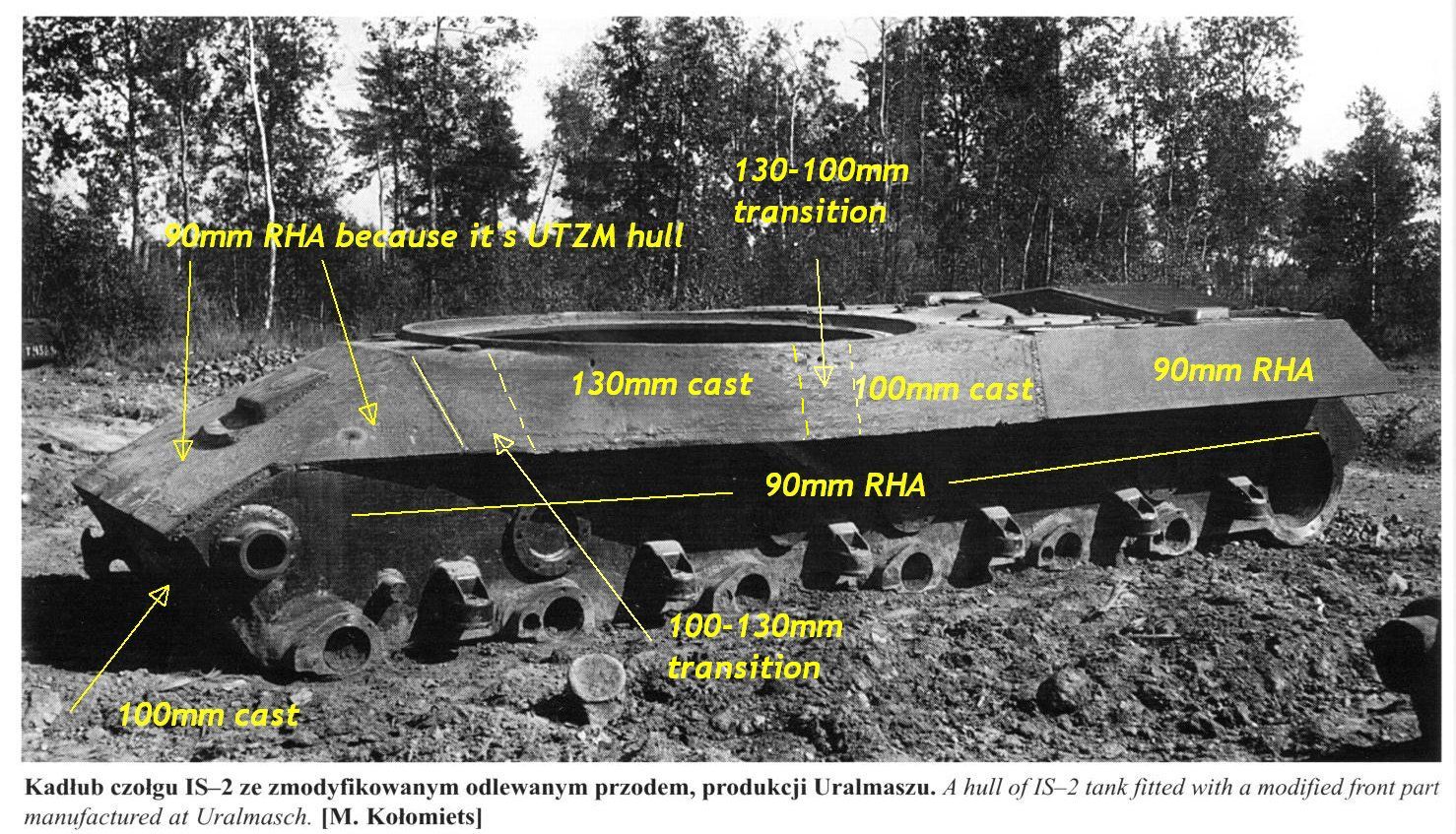 IS-2 new hull UTZM, chyba RHA z opisami by Marcin Ostrowski, on Flickr
IS-2 new hull UTZM, chyba RHA z opisami by Marcin Ostrowski, on Flickr -
And one more picture. After comparing my photo of measurements with technical drawing of Is-2m front hull, I see that point of my most forward thickness measurement (135mm) of this part could still be behind the100-130mm transitiion area.
So it's quite possible that the 100-130mm transition is there. I'll check this next time.
-
The shot trap I talked about would be some relatively thin front turret armor behind the lower edge of the mantlet. A shell that bounced from uper edge of hull upper front plate would hit just there, bypassing the mantlet. I say "would" because it turned out that the armor there is not thin and there is no weakpoint at all.
Such relatively thin armor is visible on IS-1 turret blueprint, but it is very small area and there is rather small chance that a bouncing shell would hit just there. On Is-2 the turret front is longer so this part of armor is longer too and more exposed. I believed the front turret design is similar like in Is-1 so this part under the lower edge of is about 60mm thick (at best) and it would be a weakpoint then. I couldn't measure it unfortunately, it is very hard to reach from inside, and too rough to use ultrasonic meter from outside.
But on Is-2 turret blueprint that I have found few days ago, this part is visibly thicker than in IS-1, it's about 80mm thick. I suppose they corrected it while designing new turret front for 122mm gun because this part is "thick by design", not "reinforced" - the whole turret front armor geometry is designed in a way that makes lower part of the front turret thicker than upper part.
Those IS-2 blueprints are probably of early IS-2 models. One shows whole old IS-2 model with two-piece nose and old narrow mantlet type and gunsight, second shows turret with new mantlet (TSh-17 gunsight visible).
On the other hand, much later piece (from very late 1944 or maybe even early 1945) of Is-2 from Lebork has only some minor modifications - on the whole it seem to perfectly agree with the early Is-2 blueprint. I doubt that during production there were any serious modifications other than known ones (new front hull design with upper front-side belts reinforced, and wide mantlet model) as any such change would slow down the production rate for some time. Quantity was much more important than quality. Only small details (things that didn't require changes in production line tooling) were improved.
I'll try to visit some early (narrow mantlet) Is-2 model, I wonder if I find any differences in turret design. But I have to wait for springtime - we have -15deg C here now, and I can't measure anything in thick gloves ;).
-
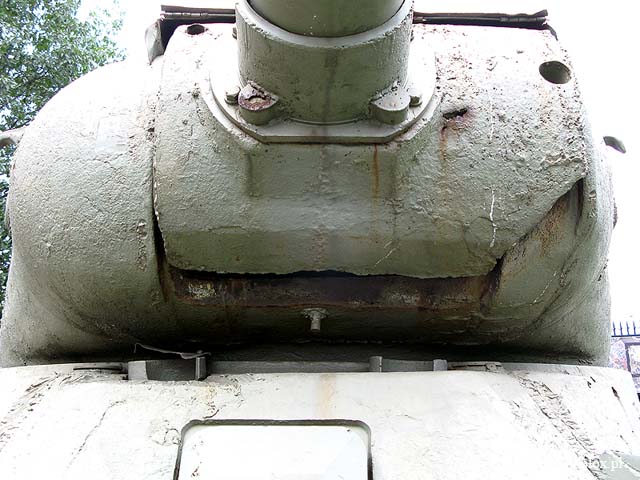
Interesting thing to notice on above photo - the armor under the mantlet is only about 40-50mm thick, because it's almost horizontal and normally also shielded by lower mantlet. But if an armor piercing projectile hit top of upper front plate or even skidded from the turret ring protector and was deflected slightly upwards, it would hit exactly there with almost full energy, probably penetrating the thin cast armor there and entering turret under the gun. Especially in late tanks with 60deg upper plate I see this as a shot trap.
After looking at some new blueprints of ture IS-2 turret (not Is-1, as before) with armor cross section visible, I have to withdraw the above statement. From those drawings I attached below, it seems that constructors have foreseen the shot-trap problem and eliminated the weakpoint I talked about by making the IS-2 under-the-mantlet armor much thicker than corresponding upper part. I didn't measure this lower part (there was no way to measure it with tape measure, and the surface was too rough to measure it with ultrasonic meter), only the upper part. I assumed the turret armor has some kind of vertical simmetry and the lower part thickness is similar to upper part. From those drawings it seems that it isn't. The lower part under the mantlet is distinctly thicker.


so on this drawing below, the lower part of armor marked with arrow is not right (too thin):
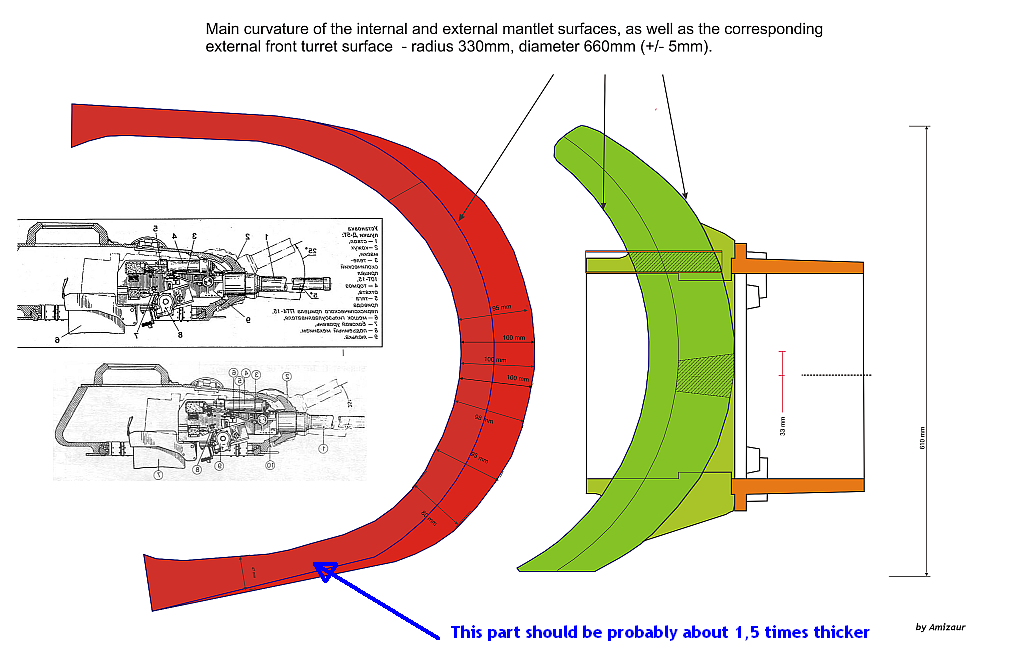
Seems for me that there is probably no under_the_mantlet weakpoint for IS-2 (there may habe been for IS-1). The only part prone to penetration in this area is the vertical part of turret ring. But turret ring is probably about as hard to penetrate as front turret (about 100mm of same cast steel + some obstructions on the way of the projectile) so it's hard to call it a "weakpoint" really. I'll try to verify this next time.
-
Looking for that info, I found few nice photos:
Few new photos I found on the net - showing the turet shape under the mantlet and opening for the gun:
IS-2 turret with it's gun mantlet removed - notice the visible rubber shock absorbers on the mounting where the mantlet is fastened:



I wish it was a little closer than 350km from me

-
And comparison of the blueprint with my drawing of mantlet profile (which was constructed only on base of measurements, I didn't use blueprint at all).
It fits suprisingly well:

My mantlet seems slightly more thick. Maybe it's an artifact of inprecise blueprint, or maybe the older 1943 (narrow) mantlet was 100mm ?
-
Some interesting photos and drawings (repost from another forum, because pictures are worth to be shown here):
Below is armor diagram of IS-1 tank with 85mm gun and basically the same narrow type mantlet as IS-2 mod 1943. You can see that opening in armor is almost same size as the mantlet width. There is only a small 20mm wide and 40mm thick ledge of front turret armor that overlaps with 115mm of mantlet armor.
(if narrow mantlet was also 115mm too, I can't know that untill I find one and check it). A shell hitting the joint of mantlet and turret would penetrate much more easily, going along this slit. BTW, on this picture the thickness of the narrow mantlet looks identical to front turret thickness so 100mm. But I'm not sure how detailed and precise this drawing is. It's from tank manual, showing how the gun is mounted, not a technical factory drawing.

Here is diagram of Is-2 turret armor with wide mantlet. It's almost identical, it differes by the left main part of mantlet (lower part on this picture) being a little wider and a 75mm thick extension added to it that covers thinner (80mm) part of front turret armor with optics port (area marked as 26 on the picture). But the main thick part of mantlet overlaps with turret armor still only by 2cm wide and 4cm thick gig of turret armor.
BTW, mantlet was mounted to the main gun on a rubber shock absorber (labeled 28).
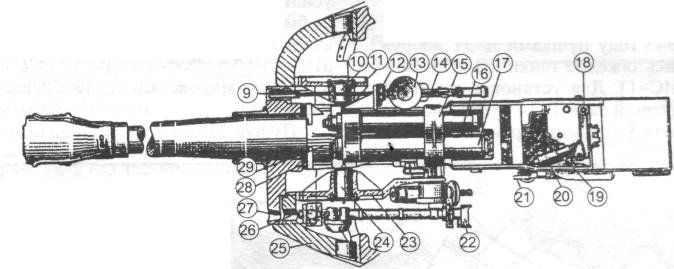
In another album (called "IS-2 tank photos - today", or something like that) there are some photos of IS-2 tank with it's gun mantlet removed - dimensions of the opening in front turret can be seen there - it's barely covered by this sheet metal cover.
Compare those two photos:
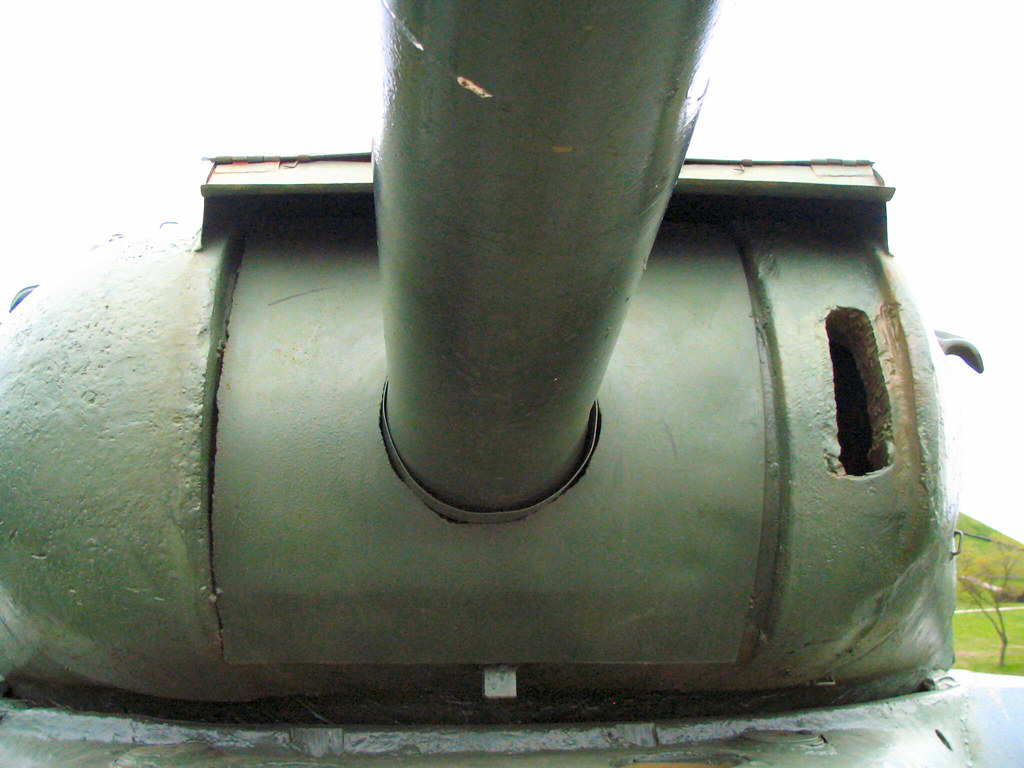
on above photo the part on the right (with oval/vertical opening for telescopic gunsight) is 80mm thick.
On picture below, it's covered by a 75mm thick mantlet extension (of trapezoidal shape), added to the main, thick part of the mantlet
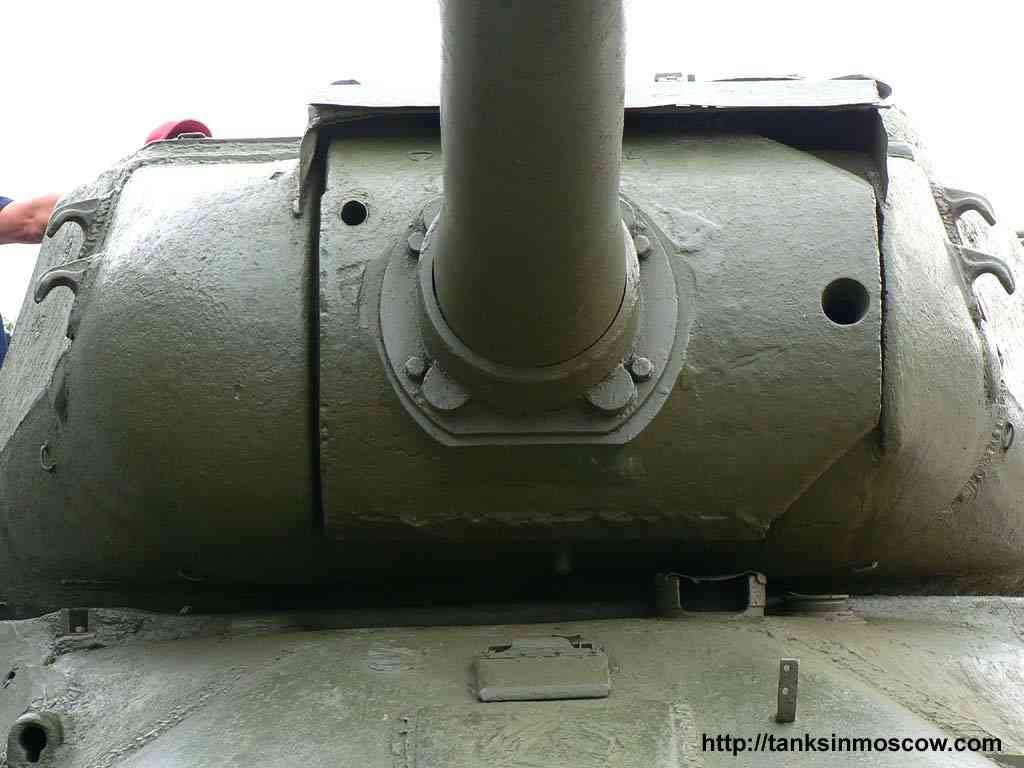
Below is top view of upper turret. Look at those lines on armor above (below on the picture) the mantlet - they help to locate.
(Compare this with the model photo below.)
Those two vertical lines visible on armor that are closest to the center are NOT where the opening in the turret armor is.
Opeing is only about 2cm from the edge of the main mantlet part.

This is how opening looks like, unfortunately only in model, but it is done accurately:

And here, looking closely under the mantlet, you can see the edge of the opening in front turret. As you see it's just like in the model photo above, opening is almost as wide ans the main part of the mantlet:

Interesting thing to notice on above photo - the armor under the mantlet is only about 40-50mm thick, because it's almost horizontal and normally also shielded by lower mantlet. But if an armor piercing projectile hit top of upper front plate or even skidded from the turret ring protector and was deflected slightly upwards, it would hit exactly there with almost full energy, probably penetrating the thin cast armor there and entering turret under the gun. Especially in late tanks with 60deg upper plate I see this as a shot trap.
Detonation of 88mm HE shell in this space (between top hull and turret, under the mantlet) would probably remove the turret from it's mounting and possibly kill the driver by splinters from the top armor above his head...
Vertical cross sections:
IS-1:

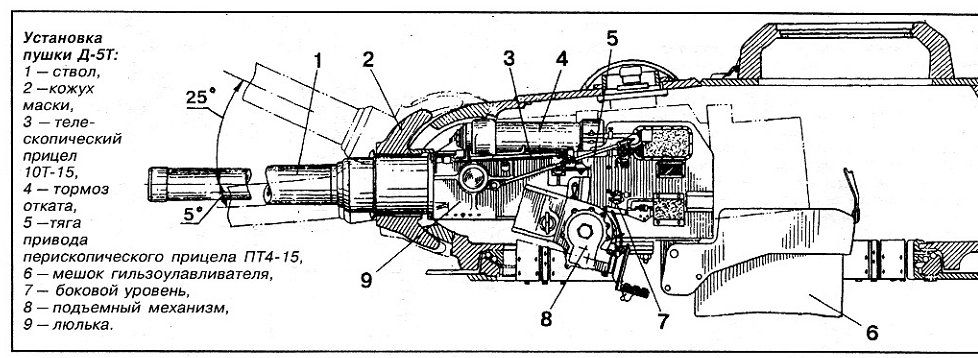
IS-2:
(unfortunately the turret armor is not shown here - and it's worth to note that the front part of turret armor (the bolted-in, rounded part) is different for Is-2 than for IS-1. In IS-2 it's longer because the gun pivoting axis is moved further forward. So the drawing of IS-1 front turret armor can not be used to understand how Is-2 front turret armor looks. Only the main turret part (central and rear one) is identical. The front "bolted" part is different.

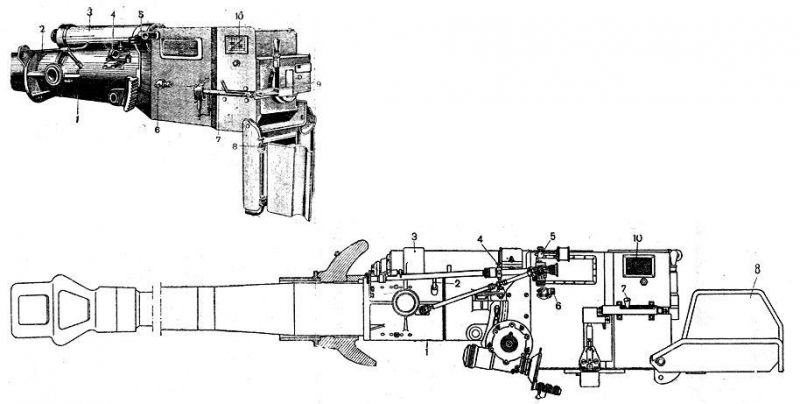
-
The matlet is made from two parts. The central one is similar to the old "narrow" mantlet - up to 115mm thick, gets thinner toward top and bottom. The right (on the picture) "added" part that covers optics area is 40mm thinner (so up to 75mm), also gets thinner up and down. Check the horizontal mantlet cross-section on another picture. Also check those two albums on flickr
There are pictures of IS-2 tank front turret without mantlet, the thinner "around optics" area is clearly visible there, it helps to understand the shape of the mantlet.
-
Original DW was unplayable for me :), fortunately there were many ways to improve things - modyfiing not only the parameters in database, but the scripts that decided how every platform in game (ship, sub, missile, torpedo) behaves, moves, "thinks". So we could design new more inteligent and more realistic scripts, that made weapons behave like real ones (their physics, logic, sensors) and make enemy ships smarter, also to correct many bugs in original scripts and even to find workarounds for some bugs in game engine (untill they were fixed) or do some things (like handling ship damage) in our scripts instead of being done by the main game engine. It was a good game, after all, because it allowed those modifications :).
-
Thank you very much for your kind words. Thank you for kind words. I`m really glad that my works are pleasing for someone :-).
That second person on pictures is my future wife

Fortunately, there is only one Amizaur nick in the world :). The nick came into being somwhere in late 90's because I used an Amiga computer then (and still have it somehere) and was proud member of it's community (I'm still today). It turned out to be quite unique, so it stayed... :).Yes, I was working on improving improve Dangerous Waters sim, but it was long ago :). I also did a small mod aimed at increasing realism of tank part of Red Orchestra game. My interests and hobbies includephysics, science and history. I also like to test and work-out game mechanics of sim games (and find bugs) so they can be improved. ;P. Have to admit that working out game mechanics takes out the whole fun from the game itself (when you know how everything works under the hood, that there is no magic there), but I just can't resist not to test and check things... ;). Long ago I played CMBB a lot, but in CMRT I did probably 10x more testing than actual playing "for fun"... same was in Dangerous Waters back then. And that is sad, because that probably means that I'm either too old or too curious, inquisitive and questioning to actually enjoy games...

Cheers !
P.S. In those new albums I have uploaded everything related to IS-2 (pictures, schemes, photos) that I found on the net and used to better understand the subject.
-
Nope, no King Tigers in Poland at all... but... IIRC there is a front turret plate from KT (dug-out part of blowed up tank) somwhere in Poland. Stripped of the zimmerit, easy to measure. Seen pictures of it somwhere on the Web.
Got it.
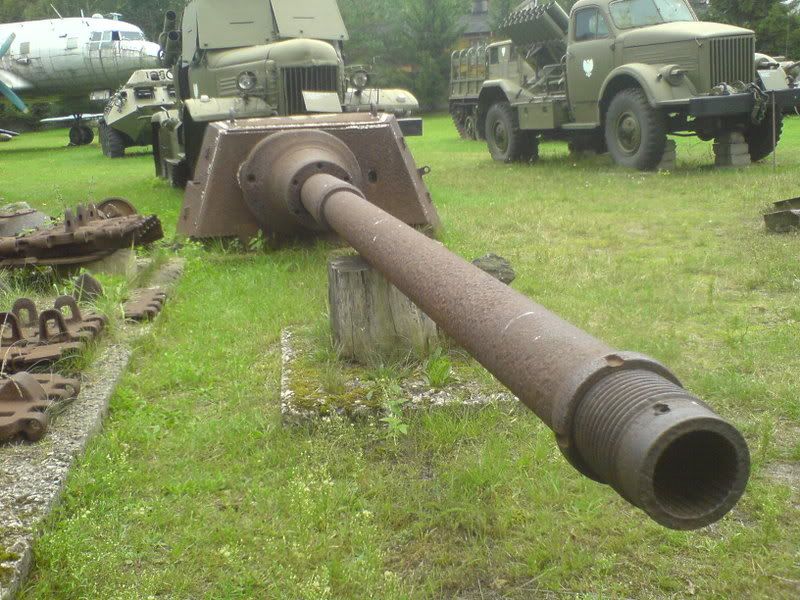
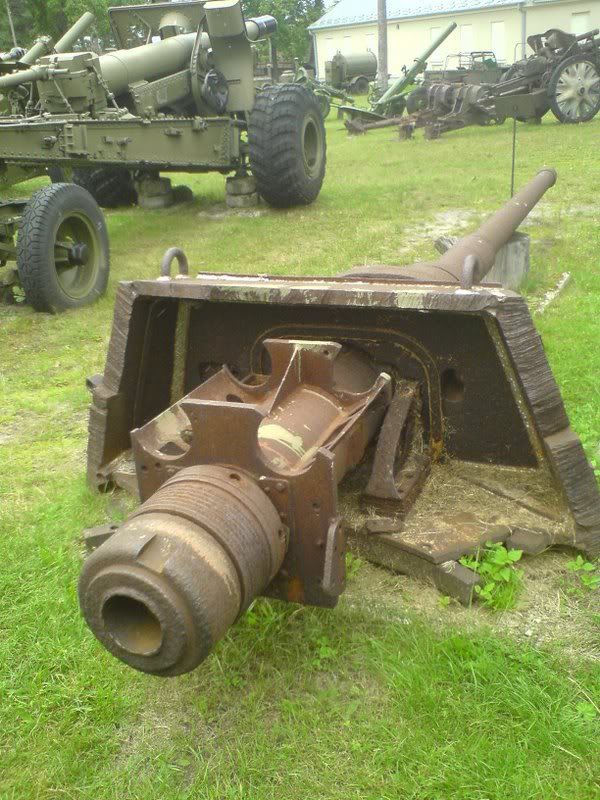
http://www.strefacichego.pl/?module=museums&id=73
What do we need to know about KT front turret ?
P.S. I just checked that this museum with KT front turret is located at Skarzysko Kamienna town which... I'm just passing trough about twice a year when traveling from Gdansk in north Poland to Krakow on the south, visiting my family there. Lot's of good stuff laying there in grass, so I'm definitely going to do a short stop while traveling this route next time

-
Hello everyone!
I'm a long time fan of wargames focusing on armored warfare (Steel Panthers and CM series, mainly Eastern Front) and also tank sims like Steel Beasts and Steel Fury. I always appreciated high level of detail and accurate, realistic modeling of equipment (like optics) and physical events (like spotting, targeting, shooting, ballistics, armor penetration and post-penetration damage).
As time passes, games (some of them) become more and more realistic with help of much more armor & penetration data available today, than were not available 15 years ago. For example today we know that the mantlet of Tiger I tank is not uniform 100mm, which we believed 15 years ago. For years the 100mm was "official" because it was cited by reputable sources and authors.
Another example is the armor thickness of IS-2 front turret and mantlet armor. All information that is available is that it's 100mm thick and that idea of thickening front turret armor was considered, but was rejected because it would cause the turret to be unacceptably unbalanced. But the turret is rounded and mantlet is not an uniform piece of steel. It's visibly thicker at center and thinner above and below, the new wide mantlet also had some area where mantlet armor and front turret armor were overlapped. Some sources claim 160mm thickness for IS-2 front turret armor. Some people wondered if the new wide mantlet was same thickness like old narrow one, or not ?
For years I observed people citing various sources (books) and debating which one is more reputable - I wondered why nobody just take a ruler, visit some museum or monument and just measure it to end the discussion ? For almost decade nobody did anything to satisfy my curiousity, so one day I decided to do it for myself.
Fortunately, I live in Poland. There are some nice samples of war production IS-2 tanks in my country, some in museums, some others on monuments. The nearest one is in small town of Lebork some 80km from the place I live - model with new one-piece front hull armor and wide mantlet. So one sunny day I just took a ruler, a camera, and went to visit the beast to measure it personally and "just know". Measuring it was not so easy, some parts are hard to reach, some are unreachable from either outside or inside, it turned out that the data I gathered was not consistent/unambiguous so I visited it again few month later to do some additional measurements and check again some details of armor layout - it turned oout that you have to know the armor layout to measure some elements correctly. With additional data I finally knew the maximum thickness of mantlet armor and was able to reconstruct the armor layout of front turret and mantlet of IS-2. While visiting friends I had also an occasion to visit another IS-2 example, model with an older two-piece front hull armor but same turret (wide mantlet) which is displayed as a monument in Nowa Huta (part of Krakow city). Measuremensts have shown that thickness of the mantlet is almost the same. The "almost" thing is probably effect of war production of crude cast armor elements.
Few years later I got my hands on simple but functional ultrasonic thickness gauge (OK, OK, I admit - bought it just for armor measuring :-)). So I visited both IS-2 tanks again to confirm my measurements with ultrasonic meter and to measure some armor elements I could not measure with a ruler. Using the meter on a rough surface of crude Russian castings - that were covered with many laters of old paint - turned out to be next to impossible. But after some effort I managed to find some small, smooth places stripped from paint where I got solid readings. There were no problems with measuring RHA plates - they were much more smooth, so finding good place was much easier. Using the ultrasonic thickness meter I could confirm thickness of front armor plates, side armor, side and rear turret armor, and of course front turret. I also confirmed my previous physical measurements of mantlet armor.
Now I could not only say how thick is armor in various places, but also reconstruct the armor layout of front turret and geometry of mantlet piece - it's theoretical geometry because the real one can differ up to +/-10mm from the "nominal" thickness. The casts are so raw and crude that such differences of +/-10mm are quite normal when measuring for example thickness of cast front hull armor "plates" in various places. Talking about armor layout and geometry - there were some differences between tanks I measured and drawings I have found on the net. There were also some differences between those two tanks I measured. I guess it's the effect of war production realities - every factory did everything to simplify the production and did their own cast moulds, so tanks from different factories and different production batches varied in details, there were some improvements and some reductions and simplifications also. Details and dimensions that were not very important, were changed if that simplified production. So there are no absolute dimensions. There are only dimensions I measured on two pieces of IS-2 tanks, and using this data I tried to guess what were the dimensions of the original project designed by some intelligent and rational engineer at drawing board. Some big dimensions shown on my drawings are still not measured, for example the exact height of the mantlet piece. I didn't have such a big calliper to do that
 , the height is derived from other data but it may be not more than +/-10mm off.
, the height is derived from other data but it may be not more than +/-10mm off.Finally I satisfied my curiosity. And now while having such load of data, including ultrasonic measurements, I thought that it may come in useful for others, so maybe I'll do some effort to put all this data together in nice graphical form and publish it on some wargamer's forums. I have also uploaded all photos I did while visiting those tanks, some of them documenting the measurements I did.
All results on my work are available for everyone in my public albums on flickr.
https://www.flickr.com/photos/136792894@N05/albums
I hope this data will be used to improve armor modeling of IS-2 tanks in Combat Mission Red Thunder and also some other games I enjoy to play (for example War Thuner).
Here are links to flickr galleries with my work (drawings based on measuremensts).
Is-2 Tank - results of armor measurements https://flic.kr/s/aHskrCY57j
and galleries with photos documenting my visits and measurements:
IS-2 Tank, Poland, Lebork 1 https://flic.kr/s/aHskqLEAcw
IS-2 Tank, Lebork 2, Poland https://flic.kr/s/aHskrtkGkA
IS-2 Tank, Poland, Lebork 3 (thickness gauge) https://flic.kr/s/aHskq9HPoj
IS-2 Tank, Poland, Lebork 4 (thickness gauge 2) https://flic.kr/s/aHskqWLgQy
IS-2 Tank, Poland, Krakow/Nowa Huta 1 https://flic.kr/s/aHskntK6iX
IS-2 Tank, Poland, Krakow/Nowa Huta 2 (thickness gauge) https://flic.kr/s/aHskqPsCB6
Ih shorts, the results are:
- the turret armor of IS-2 tank (model with wide mantlet) is 100mm all around. There are some differences due to crude castings, actual thickness vary from 90 to 100mm, with most of turret being 100mm. The armor of rounded parts (mainly front turret left and right of mantlet) becomes thinner up and down, where the angle increases. My drawing of front turret armor profile is approximate, I measured troughly only the front curved parts.
- the turret armor in area of the gunsight port is thinner, about 80mm thick, but it's covered by 75-80mm thick part of mantlet armor. So armoring of this area is really 75...78mm of mantlet armor + 10-20mm of air + ~80mm of turret armor.
- max nominal thickness of gun mantlet armor was 115mm in both tanks I measured. Mantlet in one tank was a bit "reinforced" in area around MG port and there up to 120mm thickness was measured, but the "original" shape would be 115mm. The mantlet is tapered up and down, becomes thinner where angle to vertical increases. I believe I reproduced the actual geometry of the cast moulds, being two cylinders 660mm in diameter, separated by 115mm (maybe they ment 110mm or 120mm in original plans, but on both tanks I measured it was 115mm). Such "model" when drawn, fits almost exactly to the measured mantlet profile.
- the left part of mantlet covering the gunsight port is only 75 to 80mm thick. It may be up to 80mm thick at center and 75-77mm thick at height of gunsight hole. The actual measurements were from 74mm to 77mm at the height of gunsight hole, depending on place of measurement and tank. The IS-2 from Nowa Huta/Krakow was 75mm, the Is-2m from Lebork was closer to 80mm. So again, thickness of that part of armor is combination of 75mm of matlet + 80mm of turret armor.
- The most thick part of mantlet is about 130mm above the gun and gunsight axis. In other words, the gun is mounted slightly below the thickest part of the mantlet.
- the thickness of other parts of armor (the hull) is in accordance with known data. For the older hull, the upper front is 120mm cast, the slanted part 60-70mm thick, lower front hull 100mm thick cast, sides 90mm. The newer hull with single piece nose - upper front 100mm thick cast (NOT 120mm), lower front 100mm, the front-side parts of upper hull up to 135mm thick and gradually becoming thinner on their way back, to 90 or 100mm (I forgot to check) where they are welded to the rear 90mm RHA plates. Lower side hull 90mm. So I can confirm that IS-2m upper front hull plate is 100mm thick for cast front-hulls. So probably it's made from 90mm plates in RHA-made front hulls. Other thing I can confirm is that front-side belts of IS-2m upper hull are thicker than 90mm, they are up to 130mm thick. Unfortunately I didn't check them for older-hull IS-2 model from Krakow. Will do that on occasion.
I wonder if I can attach some pictures here... let's try...
Hi there...
Regards,
Amizaur
P.S. If someday I get my hands on IS-2 tank with narrow mantlet, I'll check it too. I wonder it it's the same.
-
I have read the article with Kalinenok Marat Alexandrovich's memoirs. Very interesting.
For example:
"Yes, for a year of my stay at the front seven of my tanks were destroyed or burned. As for the crews, I changed them even more. For example, in late February in heavy fighting in East Prussia our corps suffered heavy casualties. In those days, German troops made desperate attempts to unblock their forces surrounded in and around Konigsberg, so we had to fight heavy defensive battles. Every day we had to repulse 6 to 9, and once even 11 (!) attacks. And in those fights my tanks were destroyed for five days in a row: one tank burned and other four were knocked out.So, by their own traction or pulled by a tractor they were evacuated to our FRF (field repair facilities) and while the tank was being repaired I was assigned to another armored vehicle with a new crew. Slightly injured, stunned and with a lot of bruises I still remained on duty. But within those five days 13 men in my crews were killed and 6 wounded..."From crews of 5 destroyed tanks - 25 people - 13 were killed and 6 wounded. That's an average of 2.5 dead and 1 wounded for a killed T-34/85.I wondered what was the probability of not being killed 5 times in a row in a tank. Probability of surviving what he described.Let's assume casualties were random and independant from each other. Probability of being killed or wounded in single vehicle knock-out was (as it turned out) 3.5/5 so 70%, and probability to be NOT killed or seriously wounded was 1.5/5 so 30%.Chance to be NOT killed or even wounded 5 times in a row was 0.3*0.3*0.3*0.3*0.3 so 0.3^5 = 0.00243 which means about 0.25%.He was really lucky man.... -
In Steel Beasts (which had opinion of being a very realistic simulation) and western tanks (M1, Leo2) the time between lasing and shooting could be be just a fraction of second.
After lasing the gun tube elevation was automatically and almost instantaneously adjusted by FCS - so lasing & shooting were almost simultaneous actions - IIRC it usually it took about 0.5s between lasing and shooting.
The target would have absolutely no time to react, it could manage to launch it's smoke grenades but the APFSDS would be on it's way (and it's not guided, doesn't care for smoke).
At least when shooting at stationary targets it was that fast. It could be a little longer if the gynner after lasing had to correct in azimuth against moving targets.
Is it the same in real tanks ? Is it the same in Russian tanks like T-72B, T-72B3, T-90 ? Never played Steel Bests 2 or SB Pro unfortunately.
IIRC in T-72M (which really didn't have a true FCS) after lasing only the aiming mark moved, so the gunner has to correct gun elevation manually - that could take a while, let's say 2-3 seconds.
-
Funny scene (not mine) from demo scenario:
Any comments ?
-
Funny scene (not mine) from demo scenario:
-
I hope we'll see an option for shorter WEGO turns (like 30s) someday... Full one minute is too long sometimes in modern fast-going battles, that's why so many people tend to play RT to have better control.
Shorter turns would solve this problem.
-
I'm familiar with the usual artillery shell and bomb burst situations, where the item balloons before the case disintegrates into a cloud of variously sized fragments, but am pretty sure I've never seen any high speed imagery of APHE detonation. With the burster charge in the base and the case walls much thicker than for standard HE, I'd imagine the phenomenology would be somewhat different.
Regards,
John Kettler
I found this discussion while looking for details of Soviet MD-5 or MD-8 fuses used in their APHE shells.
During further research in a book about Russian artillery ammo I found an illustration of APHE shells fragmentation (Cech 37mm and German 50mm ones) which may help to imagine what kind of fragmentation can be expected from typical HE burster:

Regards!
Sorry about digging out this thread from the abyss
 .
.



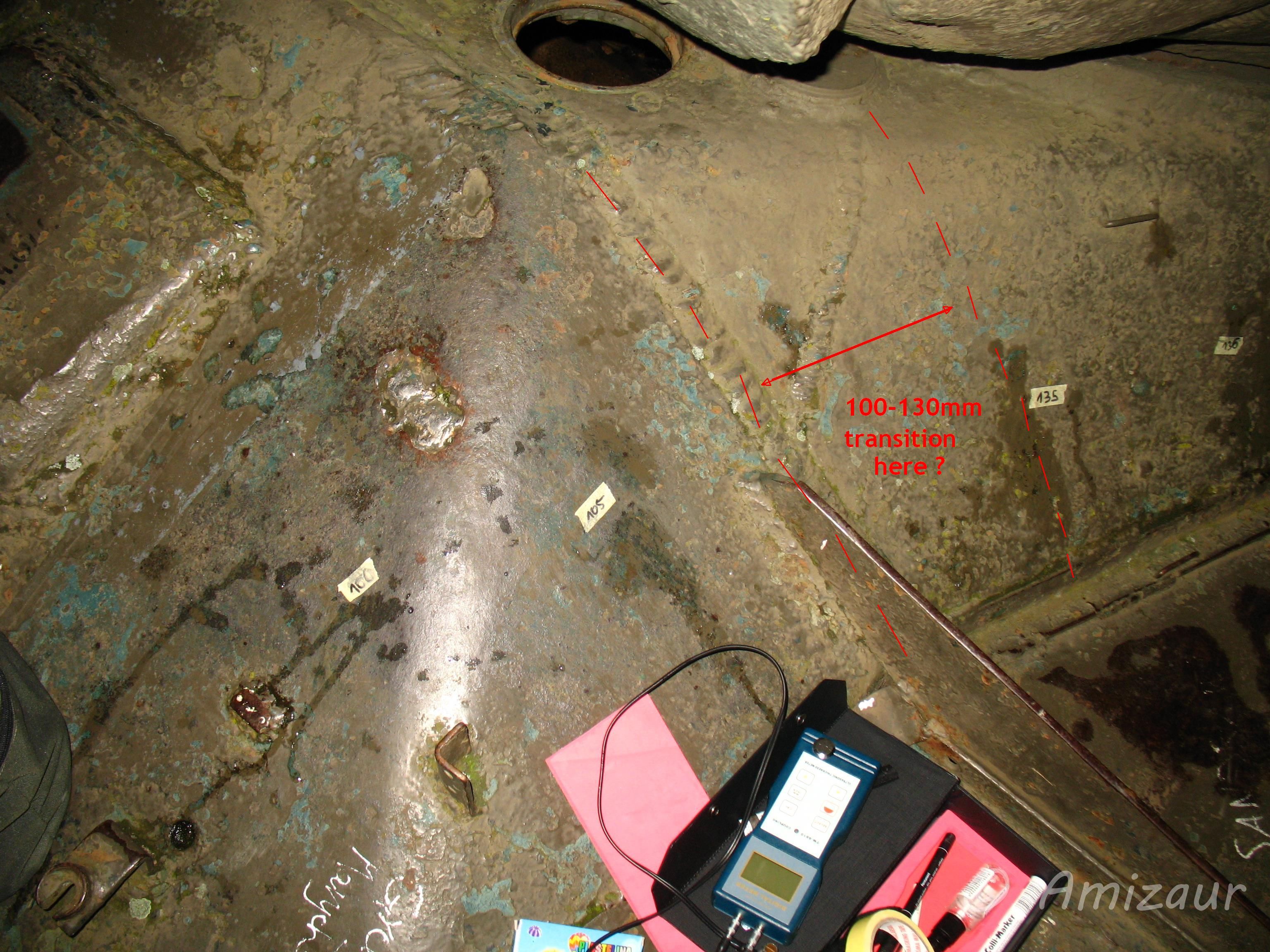

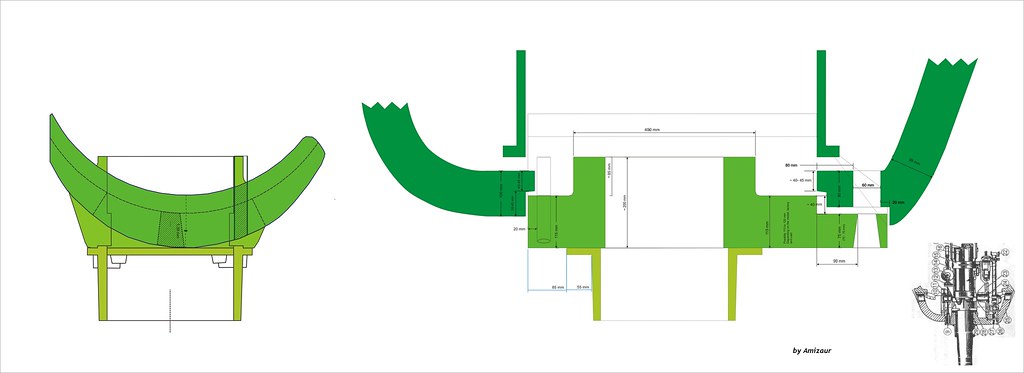

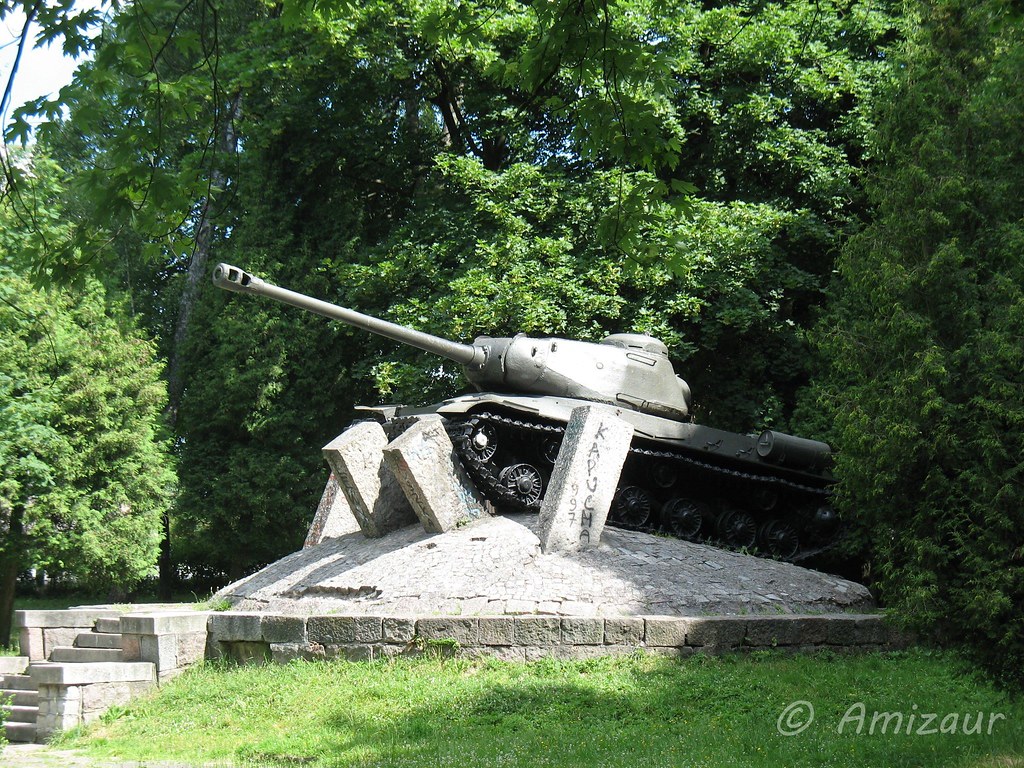
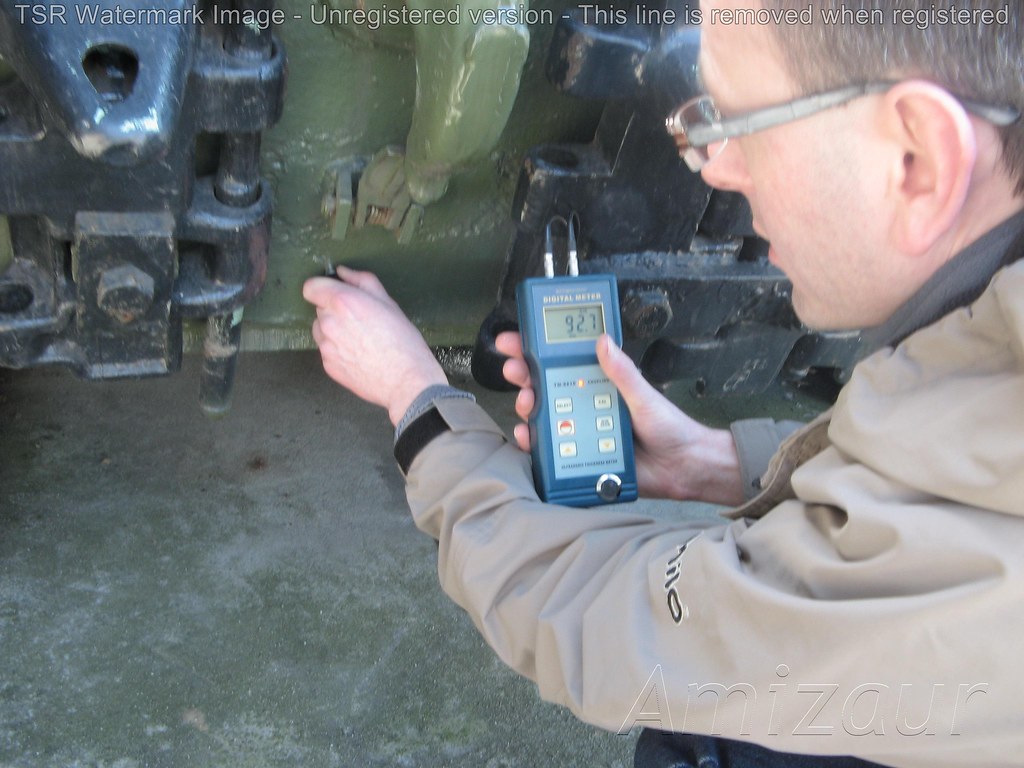
IS-2 - thickness of gun mantlet armor measured
in Combat Mission Red Thunder
Posted · Edited by Amizaur
I found en error in my first post. The bug is in the line:
"- The most thick part of mantlet is about
130mmabove the gun and gunsight axis. In other words, the gun is mounted slightly below the thickest part of the mantlet."it should say:
"- The axis (and most thick part) of the mantlet is about 33mm above the gun / gunsight axis. In other words, the gun is mounted slightly (33mm) below thickest point of the mantlet."